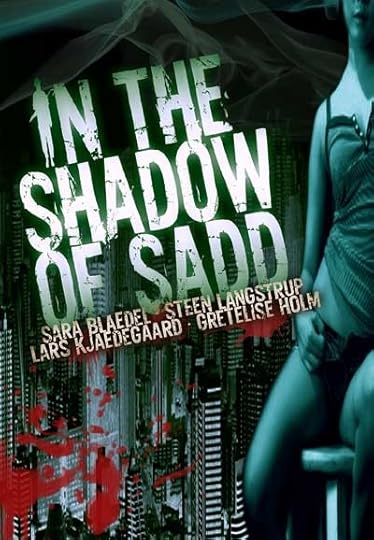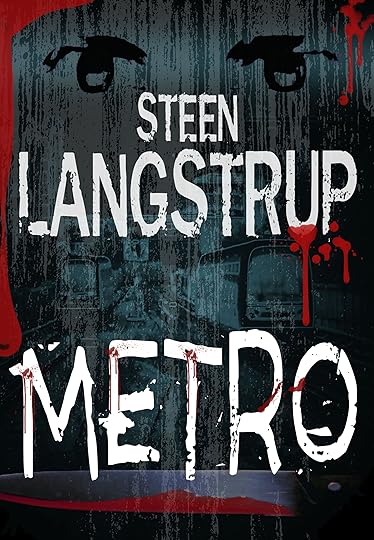Steen Langstrup's Blog, page 9
February 17, 2013
Taking a chance
 In the Shadow of Sadd was long in the making. The idea of combining related short stories to construct a novel had been in my mind for years. For old-school publishers, it was, of course, a hard sell. I didn’t have to ask around to arrive at that conclusion – if you choose to work in genres, you have to play by the genre rules. Publishers and booksellers, as well, were not likely to bite, for fear that such a title couldn’t be marketed effectively.
In the Shadow of Sadd was long in the making. The idea of combining related short stories to construct a novel had been in my mind for years. For old-school publishers, it was, of course, a hard sell. I didn’t have to ask around to arrive at that conclusion – if you choose to work in genres, you have to play by the genre rules. Publishers and booksellers, as well, were not likely to bite, for fear that such a title couldn’t be marketed effectively.
So there I was, a man with a crazy dream: I wanted not only to break the rules of the crime novel by constructing a narrative in four short stories, I also wanted these stories to be written by different writers.
I was a mad man, wanting to do a book like that.
I knew it.
It was an impossible book to get published. End of story.
Until I went indie. In 2002 I left Gyldendal, the most prestigious publishing house in the country, and founded my own publishing house, 2 Feet Entertainment, and in celebration of my newly-found artistic liberty I simply had to give this crazy project a chance.
I told myself that if we indie writers weren’t willing to risk the thin ice of the unconventional, where the established publishing world didn’t dare to tread, we did not deserve to call ourselves independent writers at all. If you believe in it, you have to take a chance and give it a try.
I knew it wouldn’t be easy. I had to find three talented writers who were willing to work on this book, and, in addition, I had to find writers who had the right voices for the characters in each short story; and they had to be writers who would accept the conditions of this project, which were basically that I was the boss.
The writers would have to stick to my plot, as there was little room for them to move their quarter of the story in any other direction. The connection between the four short stories had to fit like a jigsaw puzzle.
I was lucky to gather a team of three of the most talented Danish crime writers around, and I’m so grateful that they were willing to use their skills, their time and their patience to help me tell this story.
If you haven’t read them yet, you should check them out. They are, of course: Sara Blaedel (author of the international bestselling series featuring Detective Louise Rick and journalist Camilla Lind), Gretelise Holm (author of the bestselling series featuring Journalist Karin Sommer) and Lars Kjaedegaard (author of the bestselling Hvid & Belling-series).
And myself?
I’m just the mad man with the impossible idea.
I hope you’ll enjoy it.
(And by the way, this book ended up being one of my bestselling novels ever.)
GET YOUR COPY OF IN THE SHADOW OF SADD on AMAZON.COM
Filed under: In the shadow of Sadd

January 29, 2013
Interview with Steen Langstrup
 Interview with Steen Langstrup
Interview with Steen Langstrup
Interview on the Free Ebooks and Those Responsible For Them blog.
“At the time I wrote The Informer Denmark had troops involved in actual war for the first time since World War 2. We did have troops or ships around in past conflicts, but not in combat, and not as part of an occupying force. With my book I wanted to remind the reader that there is no romance in war, there are no heroes. It is not about good fighting bad. War is about
surviving. War leaves marks on the souls of those who fight it. War brings out the worst in people, and tend to attract some of the worst kind of people as well. AND what we really needed to remember was that the more brute force the occupying forces use (that be torture, random killings, dissappeances, you name it!) the more fierce the resistance will become.”
Visit the blog here
Filed under: Uncategorized

January 19, 2013
ON SALE NOW
 ONLY $ 0.99 for a limited time!
ONLY $ 0.99 for a limited time!
Looking for a chance to have a taste of four great Danish crime writers for next to nothing?
IN THE SHADOW OF SADD is co-written by Sara Blaedel, Steen Langstrup, Gretelise Holm and Lars Kjaedegaard.
The city could be anywhere in Europe. Sadd could be any mob boss. There is a lot of shady business going on around him, and he has a hand in most of it. This scam, however, he must never know of.
Get your copy now!
And on most other iBooks stores as well and all other Amazon stores.
Filed under: In the shadow of Sadd

November 16, 2012
THE HIPO
More feared and hated than even the Gestapo
Even today, almost 70 years after the end of World War II, the worst thing you can possibly call a Danish cop is Hipo. Mind you, that is not Hippo as in hippopotamus, but Hipo as in Hilfspolizei.
Though the Hipo Corps only existed for less than nine months during the end of World War II, their reputation of fierce and often random violence endure to this day. Known to attack and even kill innocent civilians walking the streets in broad daylight, they soon became more feared and hated than even the Gestapo. Being a member of the Hipo Corps instantly placed you on the death lists of the Danish Resistance fighting the Nazi-German occupation with sabotage.
The Hipos wore black Nazi uniforms and patrolled the Danish capitol of Copenhagen in black, gasoline-fueled cars (at this point of the war, the shortage of gasoline was so severe that only emergency vehicles had access to it). Since the resistance was known to ambush and kill the Hipo patrols, the doors were removed from the Hipo patrol cars, allowing the Hipo officers to flee the cars and return fire faster. Several patrols had—prior to this—been gunned down by the resistance while trapped inside their own patrol cars.
The Hipos were hated, all right.
However, besides their frequent use of torture and random violence against anybody who was unlucky enough to draw their attention, the Hipos were hated because they were Danes.
Of course it is never a popular choice to serve an occupying force—not today in Afghanistan or anywhere else—but this was Nazi-Germany at a time in the war where most people must have realized that Hitler was going to lose. In Denmark, during these last months of the war, the fight between the resistance, and especially the Danes serving the Nazis, only intensified, turning the once peaceful Denmark into a fierce and bloody place on the verge of civil war.
Today, the Gestapo is remembered for their reign of terror, torture and death and are regarded one of the most evil and revolting police forces ever. However, there were in fact rules and regulations for the use of violence and torture that the German officers in the Gestapo had to comply with. On the other hand, the Danes serving the Nazis didn’t care about these rules. The Danes in both the Gestapo and the Hipo would torture and kill far more freely than their German colleagues.
Even though Nazi-Germany invaded Denmark on April 9, 1940, the Danish police force continued as the main police force in the country until September 19, 1944. On this day, the Germans terminated the Danish police, deporting 2,000 Danish police officers to the concentration camps in Germany.
The Gestapo itself didn’t have an office in Denmark until sometime during the summer of 1943. Up to then, the German occupation of Denmark had been the most gentle of all the German occupations, allowing most of the Danes to go on with their lives as before. The German soldiers even nicknamed Denmark ‘The Whipped Cream Frontier’ due to the softness of the occupation. However, the sabotage by the resistance, the public strikes along with various city riots had put an end to this.
The Hipo was formed to replace the Danish police force in late 1944 in a hopeless attempt to bring some law and order back to the streets, aiming to secure production of goods for The Third Reich.
At a time when crime ruled the streets of Copenhagen and the resistance was well organized and pulling off major attacks on factories serving the Germans—and Nazi-Germany losing the war as well—it might be difficult to figure why anybody would want to join the Hipo Corps. They must have known the time was short and that there would be an aftermath once Denmark was liberated.
But of course, the men who did join the Hipo weren’t driven by a death wish—and stupidity can only count for at few of them. Most of the Hipo officers came from another Danish Nazi Corps—The Schalburg Corps—which was consisting of veterans from the Frikorps Danmark—a part of the Waffen-SS consisting of Danish volunteers. More than 2,000 Danes fell in battle on the Eastern Frontier during World War II; among them the leader of Frikorps Danmark, Christian Frederik von Schalburg, hence the name The Schalburg Corps.
Most of the members of The Schalburg Corps were already on the death lists of the resistance since they were known to carry out retaliation killings and counter-sabotage (nicknamed Schalburgtage by the public). The Nazis would kill a Dane, often at random, for every Nazi or German killed by the resistance, and they would destroy something dear to the Danes for every factory the resistance sabotaged. Among the places Schalburgtaged was the Tivoli, the Tuborg brewery, the Bang & Olufsen factory, along with newspapers, cinemas, city halls, express trains, and trams full of people.
These men were Nazis, feared and hated long before they joined the Hipo. They had next to nothing to lose, and be sure to know that they hated and feared the resistance like no one else. They had only a little time left to settle the score, little time to strike the resistance hard before the war was over.
And so they intended to do.
Read Steen Langstrup’s World War II Crime Noir Novel ‘The Informer’
Filed under: World War 2

October 29, 2012
New novel released in English
 The Scandinavian crime novel meets Grand Theft Auto in this dark and humorous gangster tale.
The Scandinavian crime novel meets Grand Theft Auto in this dark and humorous gangster tale.
Co-written by four of the best Danish crime writers in the business, In the Shadow of Sadd takes you on a bumpy ride through the grimy side streets of a gloomy city somewhere in Europe.
The city could be anywhere in Europe. Sadd could be any mob boss. There is a lot of shady business going on around him, and he has a hand in most of it. This scam, however, he must never know of.
Buy ‘In the Shadow of Sadd’ on Amazon.com

Read more about ‘In the Shadow of Sadd’ here
Filed under: In the shadow of Sadd




